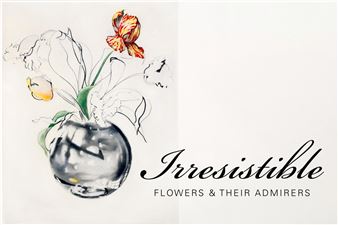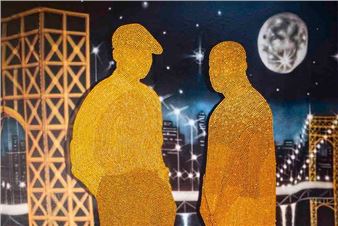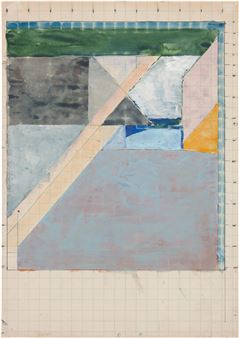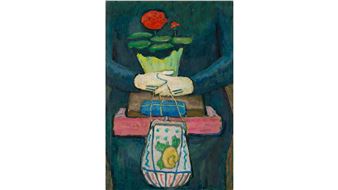Arthur Monroe: Know Your Axe
This exhibition showcases MonroeвҖҷs ineluctable works that evince their jazz and Beat influences. This is the galleryвҖҷs first exhibition of the artist since announcing representation of the Arthur Monroe Estate, and will be accompanied by a fully illustrated catalogue, with an essay by Seph Rodney.
In MonroeвҖҷs paintings, the bright yellows, deep oranges, and striking combination of contrasting colors are balanced with commanding strokes of black and white, anchored by his use of the grid, which underpins the works. Each stroke is a direct response to the one made before, and the bursts of confident spontaneity, as well as the intermittence, all lie equal on MonroeвҖҷs canvases. Much like his travels from New York to Mexico to California, MonroeвҖҷs painting is everywhere and everything all at onceвҖ“ a synthesis of each moment collected, as he navigated the 1950s art world as a young Black man, without an effort to fit in or follow a predestined path. From the white-dominated AbEx scene in the East Village, where he studied under Hans Hofmann and mingled with Franz Kline and Willem de Kooning, to the war he fought in Korea, MonroeвҖҷs life was abundant with persistence and extemporization.
As a painter who rubbed shoulders with the legends of the Beat Generation, including jazz musicians Charlie вҖңBirdвҖқ Parker and Nina Simone, and the poets Leroi Jones (later Amiri Baraka) and Ted Joans, Arthur Monroe had no confusion about painting as a categorical genre and the specificity it entailed. Art critic Seph Rodney writes in his essay for the exhibition, вҖңHeвҖҷs a bridge between the arts, the literary, visual, and musical, demonstrating that his particular creative work вҖ” paintings вҖ” arenвҖҷt a translation of some other art form; they are their own visual language, his own now and forever.вҖқ When left with the most elemental tools of image making, Monroe creates rhythm and space unique to painting, distinct from language or music.
Although Monroe was deeply engaged with the local community of creatives everywhere he lived, like many marginalized artists of the 20th century, his work and practice suffered from exclusion in art history. In Oakland, California, where he spent more than 40 years of his life, Monroe converted the Oakland Cannery Warehouse into the first legal live-work space for artists in the city and advocated for the rights of artists to live and work as he did. He also cared for the historic collection at the Oakland Museum of California as their chief registrar and taught African American studies at the University of Berkeley, and San Jose State College. Monroe remarked that being a Black artist was вҖңa tow to carry,вҖқ and for him, to carry that weight was to uplift those around him. Within this exhibition is the fruit of that devotion to art and humanity, that tireless exploration of visual culture and paint as a social force.

Recommended for you
This exhibition showcases MonroeвҖҷs ineluctable works that evince their jazz and Beat influences. This is the galleryвҖҷs first exhibition of the artist since announcing representation of the Arthur Monroe Estate, and will be accompanied by a fully illustrated catalogue, with an essay by Seph Rodney.
In MonroeвҖҷs paintings, the bright yellows, deep oranges, and striking combination of contrasting colors are balanced with commanding strokes of black and white, anchored by his use of the grid, which underpins the works. Each stroke is a direct response to the one made before, and the bursts of confident spontaneity, as well as the intermittence, all lie equal on MonroeвҖҷs canvases. Much like his travels from New York to Mexico to California, MonroeвҖҷs painting is everywhere and everything all at onceвҖ“ a synthesis of each moment collected, as he navigated the 1950s art world as a young Black man, without an effort to fit in or follow a predestined path. From the white-dominated AbEx scene in the East Village, where he studied under Hans Hofmann and mingled with Franz Kline and Willem de Kooning, to the war he fought in Korea, MonroeвҖҷs life was abundant with persistence and extemporization.
As a painter who rubbed shoulders with the legends of the Beat Generation, including jazz musicians Charlie вҖңBirdвҖқ Parker and Nina Simone, and the poets Leroi Jones (later Amiri Baraka) and Ted Joans, Arthur Monroe had no confusion about painting as a categorical genre and the specificity it entailed. Art critic Seph Rodney writes in his essay for the exhibition, вҖңHeвҖҷs a bridge between the arts, the literary, visual, and musical, demonstrating that his particular creative work вҖ” paintings вҖ” arenвҖҷt a translation of some other art form; they are their own visual language, his own now and forever.вҖқ When left with the most elemental tools of image making, Monroe creates rhythm and space unique to painting, distinct from language or music.
Although Monroe was deeply engaged with the local community of creatives everywhere he lived, like many marginalized artists of the 20th century, his work and practice suffered from exclusion in art history. In Oakland, California, where he spent more than 40 years of his life, Monroe converted the Oakland Cannery Warehouse into the first legal live-work space for artists in the city and advocated for the rights of artists to live and work as he did. He also cared for the historic collection at the Oakland Museum of California as their chief registrar and taught African American studies at the University of Berkeley, and San Jose State College. Monroe remarked that being a Black artist was вҖңa tow to carry,вҖқ and for him, to carry that weight was to uplift those around him. Within this exhibition is the fruit of that devotion to art and humanity, that tireless exploration of visual culture and paint as a social force.
Artists on show
Contact details


 ARTISTS
ARTISTS














